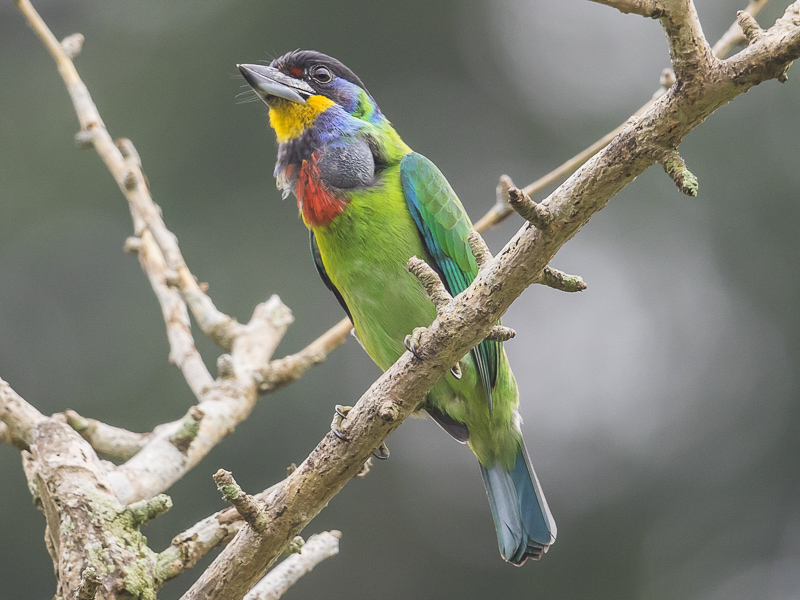Chinese Barbet Psilopogon faber 黑眉擬啄木鳥
Category I. Scarce but increasing resident in mature forest, largely in the central New Territories. A recent colonist, first recorded in 2014.
IDENTIFICATION

Mar. 2015, Matthew Kwan.
20-22cm. One of a large genus of morphologically very similar ‘green’ Psilopogon barbets, identification is greatly simplified by its being the only relatively small green barbet in HK (and southeast China) where there are no real confusion species (but beware ex-captive individuals of other Psilopogon species at least one of which has occurred). A stout bright green barbet, it is usually first detected first by its loud monotonous call. The complex head pattern with largely black forecrown, red hindcrown, blue ear coverts and yellow throat surrounded by blue and red is diagnostic.
VOCALISATIONS
The song is a distinctive and repeated, uttered in relatively short bursts often with three notes at a faster pace initially.
DISTRIBUTION & HABITAT PREFERENCE
All observations of Chinese Barbet have come from large tracts of relatively mature forest, and largely from native secondary forest, albeit a bird in Tai Lam Country Park (CP) regularly called from a large exotic eucalypt. Most records have come from upland forest, but this may be more a function of habitat availability rather than a preference for higher altitudes, as records have come from near sea level in Sai Kung to around 800m on Tai Mo Shan.
Most records have come from the central New Territories around Tai Mo Shan, extending from Ho Pui Reservoir in the west to Tai Po Kau in the east. A further cluster of observations is centred around Ho Chung whilst outliers, at least for now, have been reported from the eastern New Territories at Robin’s Nest, Pat Sing Leng, Li Chi Kok and Pak Sha O.
OCCURRENCE
Chinese Barbet was first recorded on 30 December 2014 when one was seen in Tai Po Kau and most likely the same bird was seen and heard from 19 March 2015 (Yu and Sung 2016). At least one bird was seen in Tai Po Kau until 2 May 2016 and it appears likely that breeding took place as a juvenile was photographed on 23 August 2015. There were no substantiated records in 2017; however, 2018 saw the start of an upsurge in observations, with annual totals of birds in song as follows:
2018: six birds: at Tseung Kwan O, Tai Lam CP, Tai Po Kau and Lai Chi Wo.
2019: five birds: at Tai Po Kau, Tai Lam CP, KFBG and Tai Mo Shan.
2020: six birds: at Tai Lam CP, Tai Po Kau, Leadmine Pass, Ng Tung Chai and Tai Mo Shan.
Subsequently, numbers have continued to increase and whilst most reports are of single calling birds, up to three individuals have been reported from locations in the central New Territories. However, it is now difficult to arrive at an accurate assessment of the numbers present, largely because ‘sites’ in forest in the central New Territories are ill-defined.
Whilst most conspicuous when in song, Chinese Barbet has been recorded in all months of the year and is assumed to be resident. Its arrival in HK is, however, just one element of its marked spread in southeast China since the mid-1990s (Yu and Sung 2016) and is testament to its dispersive ability.
BEHAVIOUR, FORAGING & DIET
Highly arboreal, Chinese Barbet spends most of its time in the upper tree canopy layer. There are no observations of foraging behaviour, and most records are of vocalising birds; whilst it often calls from within the canopy, on occasion it chooses a perch in the open including at or near the top of dead trees. Birds often spend some minutes calling from one spot then fly to another tree within about 100m where calling resumes.
Assumed to be wholly or largely frugivorous, Chinese Barbet has the potential to become a significant dispersal agent for trees with larger fruit; however, as yet there are no observations on its diet in HK.
BREEDING
There are no confirmed breeding records from HK, and no proof that many of the HK records are not of unmated males. Thus, whilst it is assumed that this must be taking place, the only suggestion of local breeding is the observation (and photograph) of a juvenile in Tai Po Kau on 23 August 2015. Calling birds have been noted from 22 January until at least 8 August, and this activity appears to be most intense from mid-March to late May.
RANGE & SYSTEMATICS
Chinese Barbet is endemic to southeast China from Chongqing, Guizhou and Guangxi Provinces in the west to Anhui and Zhejiang Provinces in the west. It is widespread in Guangdong Province, occurring as close to HK as Wutongshan in Shenzhen (Liu and Chen 2021, eBird 2023).
There are two races: P. f. faber is endemic to Hainan, whilst P. f. sini is found in southeast China including HK.
CONSERVATION STATUS
IUCN: Least Concern. Population trend decreasing.
eBird. (2023). eBird: An online database of bird distribution and abundance [web application]. eBird, Cornell Lab of Ornithology, Ithaca, New York. Available: http://www.ebird.org. (Accessed: 27 December 2023).
Liu, Y. and S. H. Chen (eds) (2021). The CNG Field Guide to the Birds of China (in Chinese). Hunan Science and Technology Publication House, Changsha.
Yu, Y. T. and Y. H. Sung. (2016). Chinese Barbet Psilopogon faber. The first Hong Kong record. Hong Kong Bird Report 2014: 295-301.

